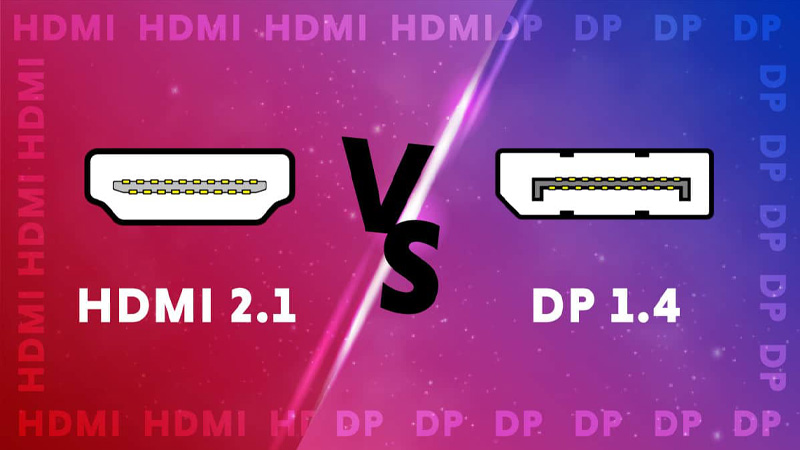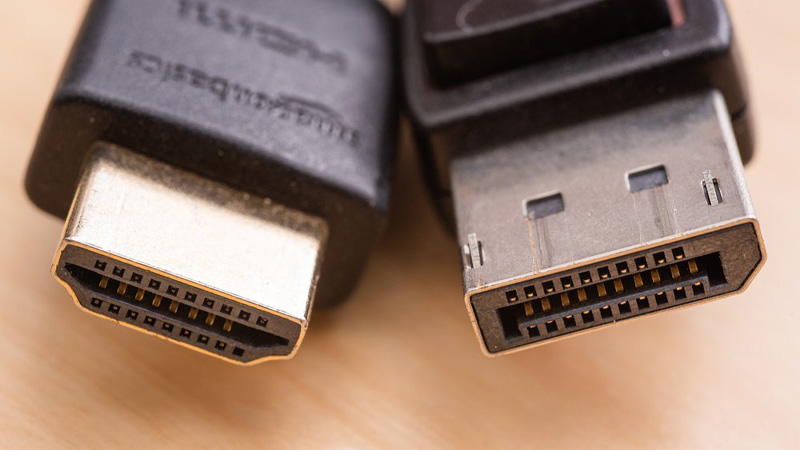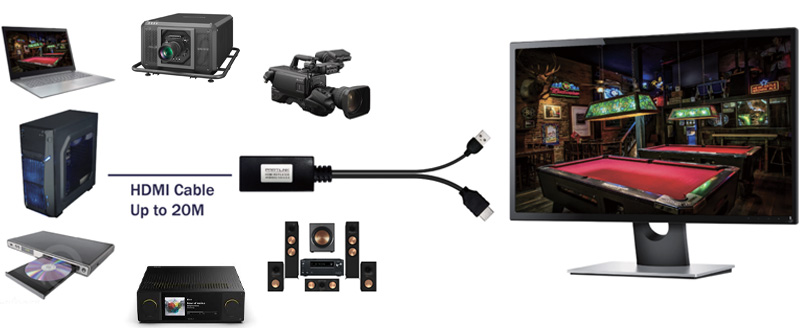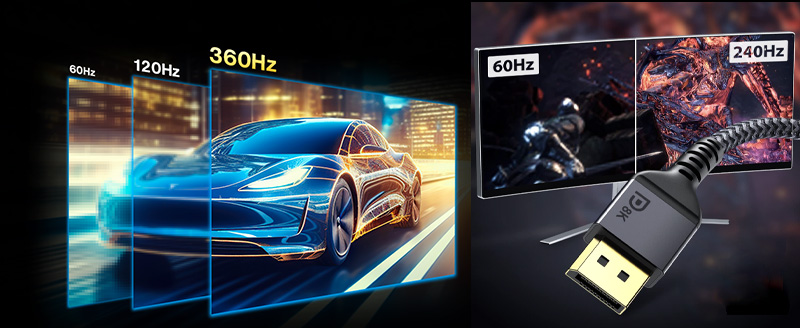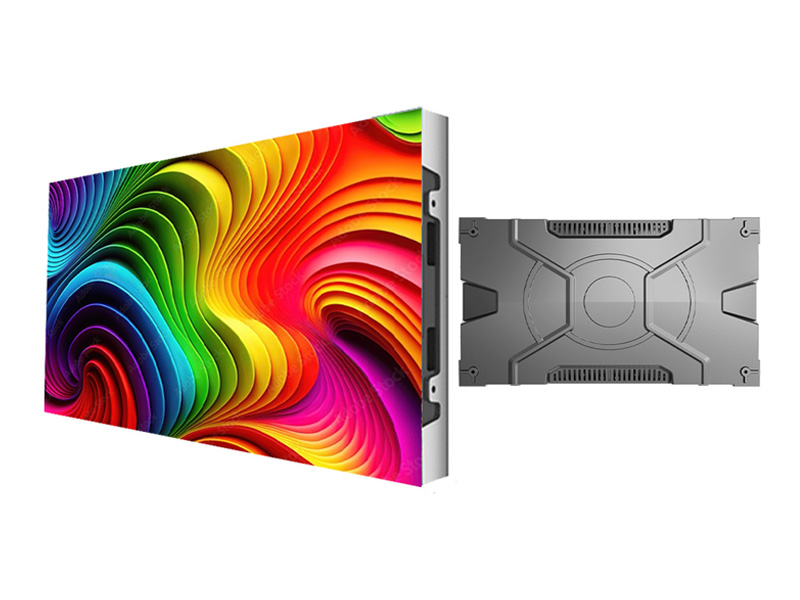DisplayPort 1.4 vs. HDMI 2.1 – Definitive Comparison 2024
In recent years, the sphere of video connectivity has undergone significant changes, and within this domain, you will see DisplayPort and HDMI taking the lead in terms of primary standards. Both video connectivity options offer high-quality video transmission, but DisplayPort 1.4 and HDMI 2.1 are considered to represent the peak of this technology.
Did the above introduction trigger your inner techno enthusiast, and now you want to know more? That sounds great, as this blog is going to discuss its comparison regarding bandwidth and resolution, features and capabilities, color depth, and dynamic range. Which one should you choose?
Content Index
1. DisplayPort 1.4 vs. HDMI 2.1 Bandwidth
2. DisplayPort 1.4 vs. HDMI 2.1 Resolution and Refresh Rate
3. DisplayPort 1.4 vs. HDMI 2.1 Features and Capabilities
4. DisplayPort 1.4 vs. HDMI 2.1 Color Depth
5. DisplayPort 1.4 vs. HDMI 2.1 Dynamic Range
6. DisplayPort 1.4 vs. HDMI 2.1: Which One to Choose?
7. Shop From LEDSINO
-
HDMI 2.1
HDMI 2.1 steals the show by providing a bandwidth of 48 Gbps. The Gbps supports the transfer rate when you must deal with high-resolution content, particularly in scenarios where you have to combine high refresh rates, unlike other bandwidths that fail to offer you a similar convenience.
-
DisplayPort 1.4
On the other hand, the DisplayPort 1.4 provides you with a maximum bandwidth of 32.4 Gbps. The bandwidth proves to be enough for most applications, yet it remains behind HDMI 2.1’s potential. Why? Looking at the difference in Gbps, it is evident that the video connectivity alternative does not have the capability to push the limits of refresh rate and resolution.
We are going to spill the beans about the resolution and refresh rate the video connectivity offers:
-
HDMI 2.1
As mentioned above, HDMI 2.1 has a higher bandwidth, so that means that with that power, it certainly can manage higher resolutions and refresh rates. To be precise, 2.1 can support 4K at 120 Hz, 8K at 60 Hz, and even 10K resolution. The rates turn out to be excellent for gamers and like-minded individuals who look forward to immersive visual experiences and want to forget that they are enjoying living in a world of illusion.
-
DisplayPort 1.4
DisplayPort 1.4 is also compatible with tackling a similar resolution and refresh rate, but unfortunately, 1.4 may let you down in delivering the same level of performance since it falls behind bandwidth-wise. And you might not enjoy watching high-resolution content with a soaring demand.
What features and capabilities do the video connectivity options have in store for you? Let’s unveil the mystery:
-
Audio Features
Good and clear audio makes you want to listen the entire day; see how what features HDMI 2.1 and DisplayPort 1.4 offer you:
- HDMI 2.1
HDMI 2.1 keeps itself distinct as it introduces the feature of Enhanced Audio Return Channel (eARC). What is so unique about eARC? The hint is in the name that it allows enhanced or high-quality audio formats to be delivered from the TV to an audio system. You can even enjoy listening to your playlist or movie because 2.1 supports Dolby Atmos and DTS: X, redefining your audio experience, which you couldn’t find in the older versions.
- DisplayPort 1.4
DisplayPort 1.4 is running in the race for similar features, but you won’t get the top-notch audio quality like HDMI 2.1. Even if you sit down to watch your series or random channels, you might not get the crystal-clear audio, and as a result, the vibes and excitement will be spoiled.
-
Gaming Features
Gamers take their field very seriously, and they need the best options to enjoy the graphics and smooth gameplay. This is how the options elevate their gaming experience:
- HDMI 2.1
HDMI 2.1 facilitates gamers by offering gaming features like Auto Low Latency Mode (ALLM) that reduces input lag, Variable Refresh Rate (VRR) for seamless gameplay, and Quick Frame Transport (QFT) for faster image transmission. Gamers can finally say bye to those days when the old versions made their gaming more of a hassle and less of a relaxation.
- DisplayPort 1.4
Where HDMI 2.1 is receiving awards in all features, DisplayPort 1.4 is trying its best to catch up with the star, but its limitations prevent it from doing so. The video connectivity option supports adaptive syncing, which works similarly to VRR; however, the results might not be the same. The reduction of input lag may let you down.
-
Other Features
What other features do these connections surprise you with? Let’s have a quick glance:
- HDMI 2.1
You named a feature, and HDMI 2.1 already has it. The standard in video connectivity horizon offers Dynamic HDR to adjust scene-by-scene HDR settings. This provides you with a more precise and engaging viewing experience. You will enjoy watching movies and other shows.
- DisplayPort 1.4
DisplayPort supports necessary features like Display Stream Compression (DSC), which are required for efficiently transmitting data and HDR. However, it is not built with the same capabilities that HDMI 2.1 impresses audiences with.
What is color depth? If you are a newbie, then it refers to the number of bits that are used to represent each color channel separately in an image. These colors are green, red, and blue. You need to understand the logic behind color depth. Higher color depths lead to a wider range of colors and smoother color gradients. How do HDMI 2.1 and DisplayPort 1.4 impress you with color depth? Let’s read below:
-
HDMI 2.1
In the category of color depth, HDMI 2.1 casts its spell on you by supporting up to 12-bit color depth, offering a wide color palette with subtle color transitions. No wonder customers go for this video connectivity option.
-
DisplayPort 1.4
If you have DisplayPort 1.4, then you also do not need to stress as the substitute provides color accuracy and depth like HDMI 2.1. You can say that in one area, 1.4 will not make you regret your decision and will allow you to enjoy the picture and video quality.
We are moving towards dynamic range. It refers to the ratio of contrast between the brightest and darkest parts of an image. A dynamic range that is wide in nature provides you with images that are more detailed in terms of highlights and shadows. You must be wondering what difference HDMI 2.1 and DisplayPort 1.4 hold if you want to see their dynamic range. Let’s have a glance:
-
HDMI 2.1
If you are looking for options to support High Dynamic Range formats like HDR10, Dolby Vision, and HDR10+, then HDMI 2.1 is your call. It expands the dynamic range that assists in delivering images with more detailing and greater contrast. You can thoroughly enjoy watching videos and pictures due to the rich detailing that HDMI 2.1 offers.
-
DisplayPort 1.4
DisplayPort 1.4 runs neck-to-neck with HDMI 2.1. However, video connectivity has a few drawbacks in terms of offering a good dynamic range. Yes, it supports HDR, but the implementation pattern may not be as detailed as an HDMI 2.1 provides. It can manage HDR content but may not startle you with the same degree of dynamic range and features that HDMI 2.1 can bring to the table. Therefore, the wow element is lacking in DisplayPort 1.4.
Going through the blog, it must have been clear to some extent how HDMI 2.1 and DisplayPort1.4 differ from each other. You can choose either of them depending on your field’s requirements and priorities. Let us give you some idea:
-
Gamers
If you are into gaming, then HDMI 2.1 will suit you more. How? As discussed at the start of the blog, this video connectivity option amazes you with its higher bandwidth, supports advanced-level features such as ALLM and VRR, and has lower latency. These will benefit your gaming and provide you with smooth gameplay, sharp, detailed images, and hassle-free transitions.
-
Video Enthusiasts
Does your day remain incomplete without watching video content? In this case, you can try both options, but with HDMI 2.1 you will still be in a better position. DisplayPort 1.4 might not offer you the same image quality and dynamic range that HDMI 2.1 is fully capable of.
-
PC Users
Are you a PC user? Then go for DisplayPort 1.4. It offers wider adoption and can easily manage multiple displays. You won’t have to struggle to handle your work, as DisplayPort 1.4 is there to do the honors.
-
Futureproofing
Are you one of those who always has the latest equipment at home and sternly believes in futureproofing? Then, there is no need to look right or left as HDMI 2.1 is the member you need to add to your technical family. The video connectivity option provides you with higher bandwidth, and as technology advances, you won’t have to struggle to cope with upcoming options. HDMI 2.1 will prepare you well.
7. Shop From LEDSINO
Have you been planning to upgrade yourself by getting a new LED Display? Then shop from LEDSINO, and you will be good to go. Why should you trust us? It is because we have been working for the last ten years and have taken the lead in providing reliable LEDs in the market, and our store is fully stocked with rental LED, commercial LED displays, stadium LED screens, LED spherical displays, LED posters, and more.
Besides, LEDSINO carries a Certificate of Compliance as well, which means that we want you to be our customer for eternity. If you need to know anything regarding our products, then you can always call our customer representative team, who are available to address your queries around the clock.
You must be clear now where HDMI 2.1 and DisplayPort 1.4 hold the scepter and which users can benefit more from it. Depending on your requirements and priority list you can go ahead to purchase any of the two or both, if necessary.
![]() Front-end Convenient Maintenance
Front-end Convenient Maintenance
![]() Cabinet Size: 600*337.5mm/16:9 Ratio
Cabinet Size: 600*337.5mm/16:9 Ratio
![]() Compatible with 300*168.75mm Module
Compatible with 300*168.75mm Module
![]() With 3 Years Warranty and 5% Spare Parts
With 3 Years Warranty and 5% Spare Parts
![]() Front Convenient Maintenance
Front Convenient Maintenance
![]() Hard Connection, No Need Cables
Hard Connection, No Need Cables
![]() Can Removable Back Power Supply Box
Can Removable Back Power Supply Box
![]() With 3 Years Warranty and 5% Spare Parts
With 3 Years Warranty and 5% Spare Parts
Contact
 Building D, Hongfa Science Park,
Building D, Hongfa Science Park,
2035 Songbai Road, Shiyan, Bao’an District, Shenzhen, Guangdong, China.

